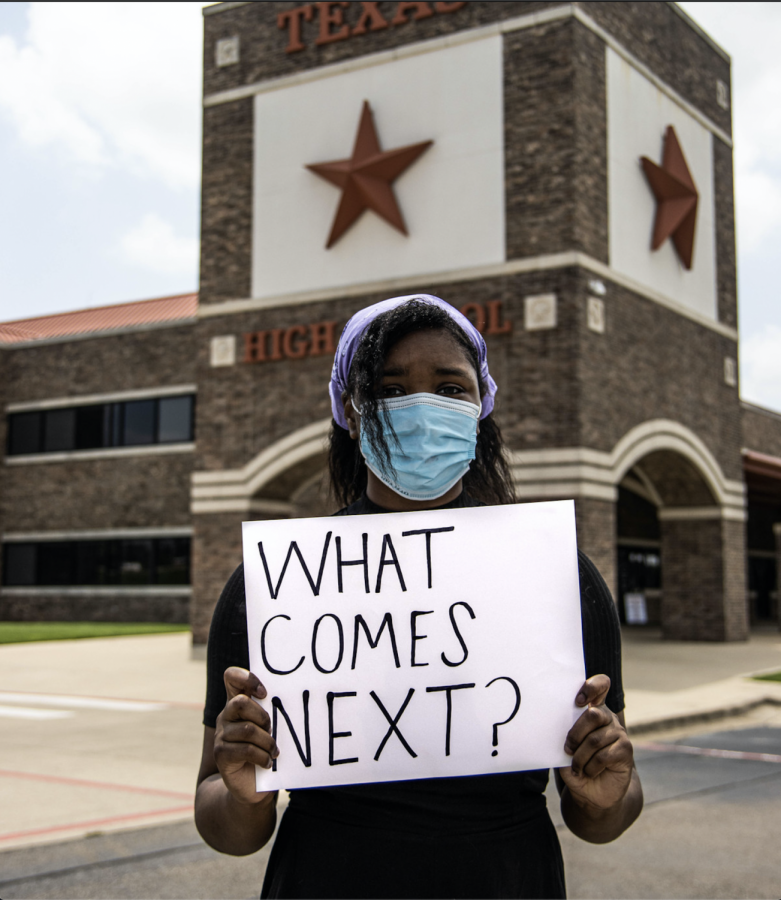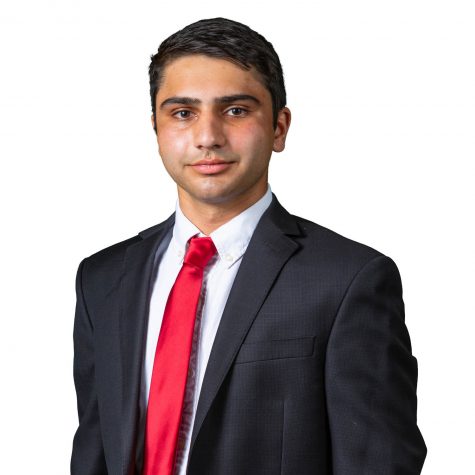The reality of reopening
Principal discusses resuming classes
Photo by Assad Malik
February 20, 2020
In the pre-pandemic world, with the end of summer came a familiar pattern. For years, students would prepare to return to classes in the same ways they always have. After all, the process was the same year after year, with little change aside from who was leading the classroom.
Obviously, nothing will be familiar about the coming 2020-2021 year. Many students are left wondering what form their education will take when classes resume, and they aren’t alone; teachers and administrators lack a complete picture all the same. For the most part, this year will require extensive learning as you go, this time, for teachers as well.
Carla Dupree, returning as principal for her third and most unfamiliar year yet, is here to field the tough questions we’re all asking ourselves about what to expect.
How are you anticipating the coming school year and the obvious challenges of creating a safe learning environment?
I’m actually very excited about the school year. It’s obviously going to look different as some will be on campus and others will be remote learners, but I’m very excited that we have the opportunity to give that choice, so that students and parents can do what’s best for them. I’m looking forward to growing and learning from this experience. Anytime you’re challenged, it’s an opportunity for growth. I think we’re going to see our staff rise to that occasion, at a campus and district level, so that we can better serve our kids.
What is TISD prioritizing for the coming year: returning back to education or creating an environment with minimal health risks?
It’s hard to actually separate those two because you really can’t have one without the other. Safety has driven every conversation we’ve had at district level leadership meetings as well as at campus level meetings. As you know, when you’re on campus, the education [we provide] is top notch. For remote learners, it’s not going to look like last spring; it’ll be real school. We want our remote learners to get the quality education they would get if they were on campus.
Where has the school sourced information about COVID-19 and the risks of returning?
We’re taking all [data] into consideration. We have a new [health coordinator] in our district, Heather Spohn, and she is getting information from the CDC. We’re listening to the TEA, the guidance of our state and local governments, and we even have Dr. Matt Young, who is advising our community with specific information. It’s not a case of ‘either or’, it’s the more information we have, the better.
What do you predict will be the biggest obstacle in returning to school?
At first, it’s gonna be the organization of it: retraining with these safety protocols and retraining in our minds what school is going to look like. For example, we are going to have far less kiddos on campus, so that’s going to help with the [social distancing]. We’re just going to have to change our paradigm to prioritize safety. I believe getting everyone to understand that this isn’t about discipline, it’s about safety, could be challenging.
Will students be able to move to virtual learning should they choose? If so, are virtual learners also allowed to return in person at any time?
Yes, if they begin the year on-site then later feel like they need to move to remote learning, students and parents can choose that at any time. Now on the second part of your question, no. Should you start off remote, you will only get an opportunity to change your mind at the end of each grading period.
Do you feel that any one choice for returning, online or on-site, will be beneficial to learning?
I think that because we are offering similar options, you can get the same experience.
Here, I really believe that there’s not a wrong choice. One of the most important things is for students and parents to feel safe.
What is the current plan for the class rank and GPA system? Can we expect class ranking or possibly a temporary pause like last semester?
As far as GPA and class rank goes, one of the conversations that I’m having with teachers, our admin team, and students is the realization that remote learning will be just like school. If an on-site student has two days to complete an assignment, that remote learner has two days to complete the same assignment with consistent quality. This is to make it consistent and comparable so that it’s fair to everyone when we look at GPA and class rank this semester.
What can we expect for large gatherings, such as athletic events, theater performances, band concerts and more?
We’re looking at how to provide the social distancing and safety protocols so we can honor all of our traditions. Unfortunately, some of those traditions and gatherings may not happen or look different, but that’s one of my favorite parts of Texas High, our traditions, so we’re trying to hold on to those as best we can. Whenever [teachers, club sponsors, or faculty members] are proposing a student gathering, they have to fill a form out that goes to the central office, and then there’s a committee that evaluates it and gives them the approval on if we actually go forward with the activity.
How is the school planning to avoid the transmission risks that crowded transition periods would create?
One thing is we’ll have less students on campus, and that will help quite a bit, actually. Another thing is, when you’re in transition, you’re going to have to wear your mask, buff, or gaiter. The district is actually providing every student with a buff so everybody will have one. You also have your choice of mask, and some of those have gotten quite stylish, so it’s not as horrible as one would imagine. Basically, if we’re in a situation where we can’t social distance, then we have to do our part to protect ourselves and protect others.
What can we expect for the cafeteria setting? Will it resemble anything like the structure it followed last year?
Number one, we’re gonna have less [students]. Those in football third period are going to actually have the lunches brought down to football. That gives us more room to move around during those three lunches because that’s 145 students [absent from] the last lunch. That gives us some wiggle room where we can spread people out. We’ll have about 300 seats available in the cafeteria and will designate those with stickers on the seat, so you’ll know where to social distance. We’re also going to add a little more seating outside, so I think we’ll be able to manage it.
Do you expect the mask policy to be followed completely, and in the event it is not, how will teachers and assistant principals enforce it?
I think I would be very naive if I thought that it was going to be followed completely. I mean, what policy do we have that is followed completely? But that’s to be expected; it’s the nature of the game. Here’s the important realization: this isn’t about discipline, it’s about safety. [Students] have a choice: you can choose to be on-site or you can choose remote learning. If you choose on-site, then you’re agreeing to our safety protocol. If you don’t want to agree to our safety protocol, I don’t even want to have a conversation with you about ISS. You’re saying to me, you need to go remote. You’re either going to be on board and do what’s right to protect your neighbor and yourself, or you can go home and not wear a mask.
How do you feel our school dealt with the pandemic in the final months of last year? Are there any major weaknesses you saw that will be improved on this year?
I think we did as good as we could do, because [the situation] was just unbelievable. I think coming out the other side, we developed some relationships with our liaisons, kids and parents which were pretty neat. Our teachers that started out really uncomfortable with the technology, stepped out, grew professionally, and added some tools to their toolbox that are going to be very beneficial for them this year and for years to come. Obviously, I think the biggest issue was the fact that not everybody has access to remote learning, the right technology devices, or Wi Fi. And that’s something that as a district, we’re working hard to make sure is not a barrier for anyone. We’ve got some conversations that have happened at the district level with businesses, a certain grant that gives the ability to provide some Wi Fi, and some devices for families in need. I think you’re going to see that make a big difference.
How can the school protect teachers who have conditions that leave them more vulnerable to COVID-19?
They have a form they can fill out if they want to request a remote position where they’re able to teach from home. However, it is a request, it’s not necessarily going to be granted. It certainly will be considered because the safety of our Tiger family is the most important thing. Beyond that, we’re going to work very hard to keep our [case] numbers down in our classrooms as best we can. Also, we have invested in disinfecting machinery, and our custodians have been schooled in the best methods and practice. We are actually adding some water bottle refill stations instead of water faucets and fountains. And then we’re also going to be able to provide our teachers with more sanitizer and face shields for them as well as masks.
Are there any other big changes to the school day you haven’t yet discussed? If so, could you describe them?
Students will have to wear masks on transportation as well. As far as the buses go, after school it’s going to be important that if you don’t have an organized, approved practice or meeting, students exit campus as soon as possible, because we’re going to need to start that intensive cleaning of the campus. Know that visitors are going to be limited on campus. It’s going to be that unless someone has to come up here in person, visitors will not be allowed on campus. Also, the staff and the student body are going to be asked to do self screenings. Each student will get a questionnaire that will have different questions to test for COVID-19. You’ll fill that out in your first period class, and teachers are doing that as well. If anyone is showing any symptoms or is sick at all, they just need to stay home.
Is there any chance that, should cases spike in this area, our school will temporarily shut down once again?
Ideally, we’re going to be able to remain both on campus and online. But as we saw in the spring, sometimes there are situations that call for measures that you didn’t see coming. And one thing I’ve learned through all this is you never say never. The goal is to provide a safe environment for kids, staff, and faculty, but I certainly can’t rule out the possibility that we may face something similar to what we faced in the spring. However, the difference is we’re going to be better prepared for that.
Who or what individuals have helped the most in planning for this unusual year? Is there anyone you would like to praise for their efforts?
I’ve been so impressed with the team effort from the central office, to instructional services, to the individual campuses. I’ve gotten in touch with my department chairs, our teachers, and held meetings that have all of us working together. Many are better than one, so there’s not been one person that has done it all. I think each person has taken their area and just worked really hard to make coming back safely a possibility for us.
















